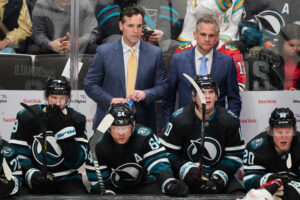As the pandemic races on, professional sports need to plan what they can do with restrictions to continue play. The NBA recently announced that it will begin its next season on December 22, 2020. That asserts pressure on the NHL to get their plans in place and some news is coming out as to how that may work. NHL Commissioner Gary Bettman along with Deputy Commissioner Bill Daly are meeting with NHL owners on November 12th to discuss the possibilities. The plan is to start the new NHL season on January 1, 2021. To accomplish that NHL temporary realignment will become necessary. The mere facts display that only 56-62 games will be able to be played to complete the season before the Summer Olympics start on July 23, 2021.
How Would NHL Temporary Realignment Work
Proposed realignment becomes necessary due to many factors caused by the COVID-19 pandemic. For one, due to the border between the United States and Canada being closed except for essential travel, the Canadian teams will need to play amongst themselves. Then, the remaining 24 teams will need to be split up into three divisions. East, Central/Southern, and West. Each U.S. division will contain eight teams. The plan would be to have hub cities that will depend on COVID-19 infection statistics.
The NHL was very successful in holding the play-in and playoffs without any positive cases of COVID-19 being reported. This plan will be different in that the teams will not be in a bubble. They would be projected to be in a hub city for 10-14 days and play four-to-five games a week. Then, they would go home for a week with testing being done on a regular basis to prevent any breakouts. The NHL should have learned from the travel that the MLB and NFL did and its complications with players being tested positive.
Divisional Team Breakdown For NHL Temporary Alignment
The Canadian division will, of course, include all the teams in Canada and they will play only other teams in Canada. Since Canada seems to have less of a COVID-19 issue compared to the U.S., travel should be less restrictive. With almost all of the U.S. states spiking with the pandemic currently, it is hoped that things will slow down by the time the projected new season commences.
The U.S. teams may be broken down into three divisions as follows:
East
New York Islanders, New York Rangers, Buffalo Sabres, New Jersey Devils, Pittsburgh Penguins, Philadelphia Flyers, Washington Capitals, and Boston Bruins
Central/Southern
St. Louis Blues, Chicago Blackhawks, Columbus Blue Jackets, Detroit Red Wings, Florida Panthers, Carolina Hurricanes, Nashville Predators, and Tampa Bay Lightning
West
Arizona Coyotes, San Jose Sharks, Los Angeles Kings, Anaheim Ducks, Dallas Stars, Minnesota Wild, Colorado Avalanche, and Vegas Golden Knights
How NHL Temporary Realignment Would Affect Play And Results
Nothing is perfect, especially in a pandemic. Will this plan limit normal play in the NHL as we know it? Of course. Is it necessary to even attempt to get back to play? It seems so. Things all depend on the COVID-19 threats and how well it may be controlled. If a vaccine becomes available the timeline for getting millions of citizens vaccinated will be a logistical nightmare. And if the vaccine is successful fans may eventually be able to attend games once again, with safety precautions in place. Let’s face it, the virus is in control, and it has changed our lives, including our recreation in following our favourite sports.
If one were to examine the results of last season with the divisional play in effect, it becomes clear that results will be very different than if all teams play other teams under normal circumstances. Take for example the results of the Arizona Coyotes last season. With this new divisional play concept, the Coyotes being limited to play against just the western teams showed that over the entire season their record would have been 8-9-3. That’s correct there were just 20 games played against the proposed west division. If you consider the first 20 games of the season under normal conditions last season the Coyotes went 11-7-2. That’s a difference of five points. As we all know five points can determine the outcome of whether a team makes the playoffs or not.
Will That Taint The Entire Season Results?
There’s no real way it can’t. Even if say half of the season is played using the divisional play concept, the results could best be described as monumental. This could even be in the asterisk category. It’s bad enough that the season must be shortened due to the league playing into late September to award the Stanley Cup. Normally the teams are playing exhibition games before a season start in early October.
In contrast, it may be said that hockey fans are starving to see games once again IN PERSON! That may not happen until the pandemic starts to lose its stranglehold on our society. After all this is sports, it’s a recreation, not life or death. The hope for the NHL is that fans will be able to slowly populate the arenas once again. For now, it is just that… a hope.
Can The Weaker NHL Teams Survive And For How Long?
This becomes a financial decision that owners will discuss with the management of the NHL. It has been said that most teams earn about $1 million per game. This includes concessions, souvenirs, ticket sales, and that would all be lost in games played in empty arenas. TV revenue is not enough to sustain some of the teams financially. Even with a new billionaire owner in Arizona, Alex Meruelo is experiencing such losses in his other businesses that he had to make cuts in his staff to make ends meet.
The dream of a new arena to attract more fans to the games is at this point, not a priority. Survival is more vital, and that cuts deep into season ticket holders who still don’t know the future of the franchise. Will the weaker teams with low attendance suffer so much that they may need to fold? Arizona has an average attendance of just 14,605. Florida has an average of 14,104. The New York Islanders can only gather 12,810 fans per game. The newly improved Ottawa Senators are at the bottom with only 12,618 fans going through the turnstiles.
Losing teams is scary. The league will add the new Seattle Kraken in the 2021-22 season and all the teams will have their cash boxes lined with expansion fees the new team must pay to join the NHL. That will amount to about $21.7 million per team (excluding the Vegas Golden Knights). That may help, but it’s still a ways off for teams experiencing cash flow issues now.
In Conclusion
The NHL has some work to do. The fans deserve to know what the plan will be going forward. Time is of the essence. If the seven teams who did not qualify for the play-in competition last season are to get back in shape for a new season, they need to know soon what is happening. They may be coming back in early December or so to training camp and may need to play some exhibition games at the end of December to get back to playing again. They have not played since mid-March, and that’s a long time ago.
There’s a ton of issues to consider and we all know that the NHL needs to think this out. They just can’t wait too much longer… time’s a-wasting.
Main Photo:






